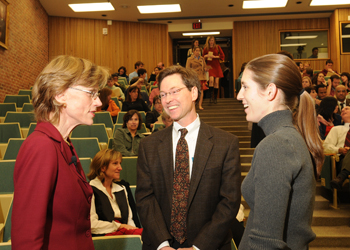
Following last week’s Discovery Lecture, Vanderbilt Prize winner Ann Graybiel, Ph.D., left, talks with Terence Dermody, M.D., and Nichelle ‘Niki” Winters, the MSTP student chosen as Graybiel’s mentee. (photo by Mary Donaldson)
Vanderbilt Prize winner explores how habits form
Smoking, nail biting, scarfing chocolate … all are habits that many people have. But why are habits so hard to break?
Ann Graybiel, Ph.D., winner of the 2008 Vanderbilt Prize in Biomedical Science, has devoted her career to finding an answer that has implications for movement and mood disorders, as well as drug addiction. Graybiel presented her research on how the brain makes and breaks habits at the Oct. 30 Paul D. Lamson Lecture, sponsored by the Department of Pharmacology and the Discovery Lecture series.
The lecture approached a serious topic — the neurophysiology of the basal ganglia — in a lighthearted manner. “We all have habits important in social situations,” Graybiel said, showing a slide of monkeys grooming each other and men swigging beer. “But what part of the brain enables us to learn these habits?”
The answer may lie in the brain's basal ganglia. Disorders in this region are implicated in movement disorders such as Parkinson's and Huntington's disease. Graybiel believes the basal ganglia also control learning, habit formation and mood.
“Emotions can be affected by manipulating the basal ganglia circuits,” Grabiel said. “These pathways are implicated in ADHD, autism spectrum disorders, depression, Tourette's syndrome and obsessive-compulsive disorder.”
The brain's frontal cortex and basal ganglia operate in loop circuits that translate intent into action, Graybiel explained. Repeating an action eventually puts these loops on autopilot. Soon actions are performed with no conscious thought. A habit is born.
Brain scans of cocaine addicts show that the basal ganglia “light up,” indicating activity in the circuits, when the addict watches a video of a person toying with drug paraphernalia.
Graybiel's research has underscored this finding. She ran laboratory mice through a maze while electrodes measured the activity in their brains. The mice were rewarded with chocolate as they learned. Soon the rodents could run the maze with no external clues to guide them. They had a maze habit.
The brain patterns of the mice altered dramatically during the stages of learning and habit formation, Graybiel said. They slowly returned to normal once the maze habit was broken.
Graybiel is the Walter A. Rosenblith Professor of Neuroscience in the Department of Brain and Cognitive Sciences and the McGovern Institute for Brain Research at the Massachusetts Institute of Technology. She is a member of the National Academy of Sciences, the Institute of Medicine, and the American Academy of Arts and Sciences. In 2001 she received the National Medal of Science, the nation's highest science and technology honor.
The Vanderbilt Prize in Biomedical Science was established by Vanderbilt University School of Medicine to honor women who have made significant advances in the biological and biomedical sciences and have contributed positively to the mentorship of other women in science.
For a complete schedule of the Discovery Lecture series and archived video of previous lectures, go to www.mc.vanderbilt.edu/discoveryseries.













